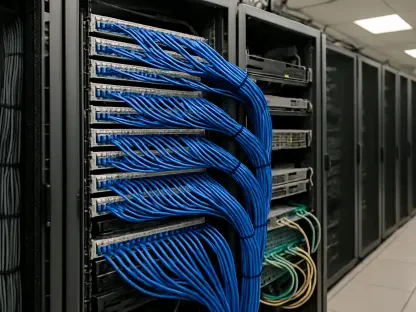What happens when the tech industry’s most energy-hungry giants decide to pivot toward environmental harmony in the heart of Silicon Valley? In San Jose, a city pulsating with innovation, a groundbreaking data center project is emerging as a potential game-changer. This isn’t just about servers and storage; it’s about challenging the notion that high-tech operations must come at the expense of the planet. Spearheaded by Arcadis and Terra Ventures, this initiative promises to blend cutting-edge technology with eco-conscious design, sparking curiosity about whether data centers can truly become symbols of sustainability.
The significance of this endeavor cannot be overstated. As artificial intelligence drives an insatiable demand for data processing, the environmental footprint of data centers has ballooned, raising alarms about energy consumption and carbon emissions. San Jose, a hub of technological advancement, stands at a critical juncture where balancing growth with ecological responsibility is no longer optional—it’s imperative. This project could serve as a blueprint, not just for the region, but for the global tech industry, proving that sustainability and innovation can coexist.
A Bold Vision for a Greener Tech Hub
At the core of this ambitious plan lies a vision to transform data centers from resource-draining behemoths into models of green efficiency. The collaboration between Arcadis and Terra Ventures in San Jose aims to demonstrate that even the most power-intensive facilities can align with stringent sustainability goals. This isn’t a mere concept but a tangible effort to redefine how the tech sector operates in harmony with environmental priorities.
This initiative stands out by addressing head-on the criticisms often leveled at data centers, such as their massive energy demands and impact on local infrastructure. By prioritizing eco-friendly practices, the project seeks to set a precedent that could inspire similar efforts across Silicon Valley and beyond. It’s a statement that technology need not be at odds with nature, but rather a partner in preserving it.
The potential ripple effect of this vision is profound. If successful, the San Jose facility could shift industry standards, encouraging other companies to adopt sustainable practices as a core component of their operations. This bold step might just position the city as a leader in reimagining the future of tech infrastructure.
Why Sustainability Matters in San Jose’s Data Center Boom
San Jose finds itself at the epicenter of a data center surge, fueled by the relentless growth of artificial intelligence and cloud computing. These facilities, while indispensable to the digital economy, often consume vast amounts of electricity, contributing to significant carbon emissions and straining local utilities. The environmental cost of this expansion has become a pressing concern for residents and policymakers alike.
Community apprehensions are mounting over how these centers impact water resources, energy grids, and overall quality of life. Reports indicate that a single large data center can use as much power as a small city, amplifying the urgency for solutions that mitigate such burdens. The tension between technological progress and ecological preservation has never been more evident in this bustling hub.
Against this backdrop, the Arcadis and Terra Ventures project emerges as a timely response to these challenges. It represents an opportunity to address local concerns while meeting global demands for greener practices. The stakes are high, as failure to innovate could exacerbate environmental strain, while success might pave the way for a more balanced approach to tech development.
Breaking Down the San Jose Project’s Sustainable Innovations
The San Jose data center distinguishes itself through a suite of pioneering strategies designed to minimize its ecological footprint. One standout feature is the use of native direct current (DC) power, which avoids the energy losses associated with converting DC to alternating current (AC). In high-density AI environments, where power usage can reach 400-600 kW per cabinet, this innovation could drastically enhance efficiency.
Another key element is the creative repurposing of waste heat, a common byproduct of data center operations. Instead of letting this heat dissipate, the facility employs absorption chillers to convert it into chilled water for cooling, boosting efficiency from 60% to 90% when paired with fuel cells. This reduces dependence on traditional, energy-intensive cooling systems, which often account for a significant portion of power consumption.
Additionally, plans are in place to channel waste heat into on-site greenhouses, providing fresh produce to the local community and cutting down on food transport emissions. This integration of agricultural and technological solutions not only lowers the carbon footprint but also embeds the data center into the social fabric of San Jose. These combined efforts illustrate a practical, multi-layered approach to sustainability that others in the industry might replicate.
Voices from the Field: Insights and Industry Perspectives
Insights from industry leaders shed light on the motivations and challenges behind this transformative project. Jeffrey Gyzen, Arcadis’ global practice group director, emphasizes the broader mission: “This isn’t just about constructing a data center; it’s about crafting a model for coexistence with communities and the environment.” His perspective underscores a shift toward on-site power generation as a solution to the unreliability of traditional utility grids, often disrupted by blackouts and brownouts.
Industry trends support this viewpoint, with many experts agreeing that decentralized energy solutions are critical for achieving net-zero targets. The push for self-sustaining power systems reflects a growing recognition that reliance on conventional utilities is unsustainable, especially as data demands escalate. This consensus adds weight to the San Jose project’s approach, positioning it as part of a larger movement.
Yet, challenges remain, as Gyzen candidly notes the impact of supply chain delays on critical components like transformers and wiring. Such hurdles are not unique to this project but are echoed across the sector, highlighting the need for strategic planning and foresight. These real-world insights ground the initiative’s aspirations in practicality, offering a balanced view of its potential and limitations.
Practical Steps for Sustainable Data Centers in San Jose and Beyond
For operators looking to emulate the San Jose model, several actionable strategies can guide the journey toward sustainability. A starting point is adopting native DC power systems to curb energy waste, with collaboration from engineers to ensure compatibility with existing infrastructure. This step alone could yield significant reductions in operational inefficiencies.
Exploring waste heat recovery presents another viable opportunity, whether for internal cooling or external applications like greenhouses. Even small-scale implementations can lead to substantial gains, and operators are encouraged to pilot such systems to assess impact. Meanwhile, transitioning to on-site power generation—using natural gas as a bridge to future solutions like small modular reactors—requires early procurement of essential equipment to avoid supply chain disruptions.
Engaging local stakeholders is equally crucial, with benefits like job creation and shared resources fostering goodwill. Designing projects that integrate community-focused elements, such as educational spaces or retail opportunities, can transform perceptions of data centers from burdens to assets. These tailored steps provide a roadmap for turning environmental challenges into competitive advantages across the industry.
Reflecting on a Sustainable Legacy
Looking back, the San Jose data center project by Arcadis and Terra Ventures stood as a testament to what was possible when innovation met responsibility. It tackled energy inefficiencies head-on with native DC power, turned waste into opportunity through heat recovery, and prioritized community integration in ways that reshaped local narratives. Each element of the initiative contributed to a narrative of progress that went beyond mere functionality.
Moving forward, the lessons from this endeavor offered clear guidance for the industry. Stakeholders were urged to invest in pilot programs for emerging technologies, advocate for policies supporting decentralized energy, and build partnerships with local communities to ensure mutual benefit. These actionable steps held the promise of scaling sustainable practices globally.
The journey also highlighted the importance of adaptability in addressing supply chain and technological hurdles. As the industry continued to evolve, the San Jose model served as a reminder that sustainability was not a destination but an ongoing commitment. It left an indelible mark, encouraging a mindset of continuous improvement and collaboration for a greener tech future.









